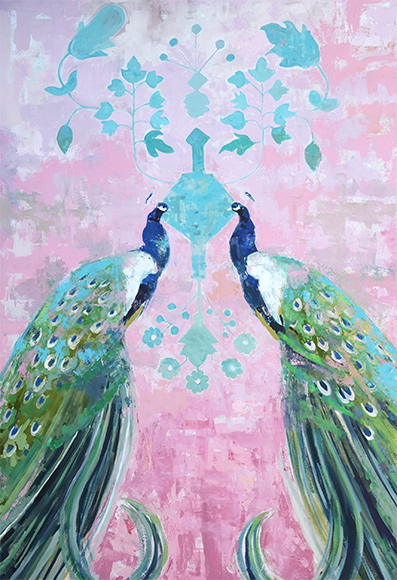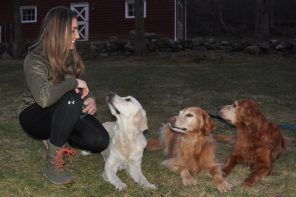Artists have been obsessed with animals ever since the dawn of civilization when our primitive ancestors created cave paintings and petroglyphs of the creatures around them. Animals are also the focus in one of Connecticut’s ongoing museum exhibitions – “Almost True Tales,” featuring the animal paintings of Brian Keith Stephens, which runs through May 19 at New London’s Lyman Allyn Art Museum.
Stephens visualizes the animal kingdom by recalling classical iconography, fables and folk tales that invested the birds and beasts with human wisdom, failings and aspirations. He provides playful titles for his paintings. “Perfect Romance” finds an opposites-attract dynamic with a willowy pink flamingo perched atop a squat giant tortoise. “I Know the Secret From the Bottom of the Sea” finds a whale descending to the oceanic depths with its lower jaw opened in a vaguely jaunty manner. “Can You See the Rooster in the Moon?” places a pair of roosters in direct view of each other, as if to anticipate a cockfight, while the ironic title suggests the silly avian rivals are incapable of seeing the proverbial bigger picture from beyond their petty barnyard domain.
“I’ve used a lot of animals throughout my work and I’ve used them with my children,” Stephens says. “With this exhibit specifically, I was relating to folk tales. A lot of them are Aesop, who used animals in metaphors for human beings.”
Indeed, several of Aesop’s most beloved fables are recast through Stephens’ imagination. “The Hare and the Tortoise,” “The Fox and the Crow” and “The Lion and the Hare” show up on his canvases. He also observes that the exhibition’s title “Almost True Tales” is related to the ongoing glut of deliberate misinformation permeating traditional and social media. In the visitor’s guide to the exhibit, the museum expounds on that concept further by noting: “At a time when the constant and omnipresent flow of information makes it harder than ever to identify what is true, Stephens’ work encourages viewers to recall the simple human virtues embodied by animals in countless tales.”
Still, Stephens laments that allegedly civilized people historically ignore the value of animals, both on the mythologized spectrum of folk tales and as participants in a living ecosystem.
“In the folk tales of the American Indians, the wolf was a superior thing,” he says. “But then when we came over, we killed them all.”
Beyond the text sourcing for his inspiration, Stephens brings a multitude of styles and substances to his work. Throughout his career, he has used mixed media for his art, often attaching cloth to the surface of his canvases, which are overlaid with broad brushstrokes and swipes of the palette knife. The works in “Almost True Tales” are created from oil and wax applied to either cotton or Canadian birch surfaces, and the result is an almost dreamlike quality, with hazy visions of the animals frequently juxtaposed against sharply defined botanicals.
But Stephens is not shy about bringing a cross-cultural vibe to his work, blending Scandinavian, Polish, Indian, Uzbek, Russian and Mexican artistic traditions. The result is a series that is both universal in tone and personality yet distinctive in presentation.
“I love playing with color,” he says. “I love playing with paint, using the brush and palette knife to get the effects that I want. It has a texture, a thickness of richness. This is a fun activity.”
For the exhibition space, Stephens moved beyond the frames of his work to ensure a visual experience that effectively highlighted his creations.
“I painted the walls a darker color, so my paintings really pop,” he says. “If I say so myself, it really looks beautiful there. Aesthetically, it is quite magical.”
Stephens, who received a B.F.A. from Connecticut’s Lyme Academy College of Fine Art in 1998 and an M.F.A. from City College of New York in 2004, has presented his work in solo and group exhibitions across the United States and in Europe. Since the Covid-19 pandemic began, he has remained rooted at his residence in Old Lyme. He had previously divided his time between Connecticut and New York City, and resided in Paris, Italy and Poland earlier in his career.
“Almost True Tales” was conceived solely for the Lyman Allyn Art Museum, with no present plans for other venues. Having an exhibition that is special to this Connecticut institution has generated a great deal of appreciation from the regional arts community and its supporters.
“People have responded quite well,” he says, adding that some of the works have already been sold to collectors while others will be packaged in future gallery shows he is planning. He also is grateful that the museum has made the exhibition available for in-person viewing and has not limited it to a virtual-only show, which has become too commonplace during the pandemic.
“The museum is very Covid-friendly,” he says. “I think it’s important to mention that people can come and see it. They are only allowing a certain amount of people at a time, but you can just show up. That’s nice, because I know people are itching to get out — and it is up until May, so it will be there when it’s warmer weather.”
“Almost True Tales is at Lyman Allyn Art Museum, 625 Williams St, New London through May 19. For more, call 860-443-2545 or visit lymanallyn.org.







